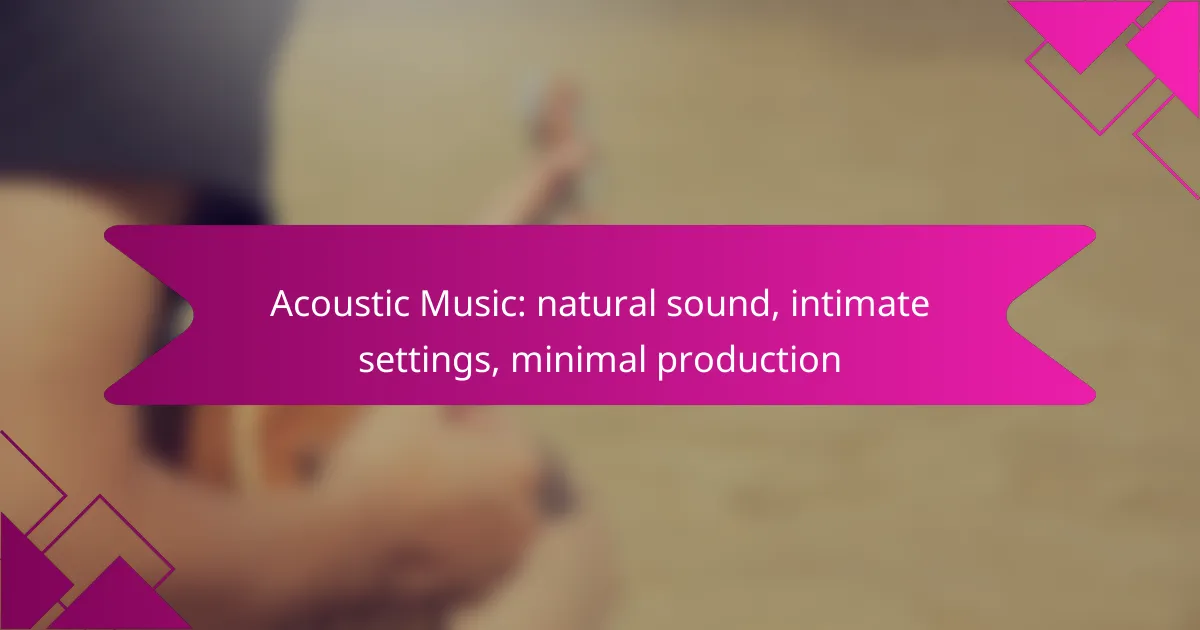Acoustic music thrives on the beauty of natural sound and the intimacy of its settings, often requiring minimal production to highlight its authenticity. By selecting the right venues and collaborating with local musicians, artists can create a deeply resonant experience for their audience. Emphasizing essential recording techniques and quality equipment allows for a rich sound that captures the essence of the performance.

How to create an acoustic music experience in urban settings?
Creating an acoustic music experience in urban settings involves selecting the right venues, incorporating natural sound elements, and collaborating with local musicians. This approach enhances the intimacy and authenticity of the performance, making it resonate more deeply with the audience.
Utilize local venues with intimate atmospheres
Choosing the right venue is crucial for an acoustic music experience. Look for small cafes, community centers, or art galleries that foster a cozy environment. These spaces often have better acoustics and allow for closer interaction between performers and the audience.
Consider venues that can accommodate around 50 to 100 people, as they tend to create a more personal atmosphere. Check local listings or community boards for hidden gems that regularly host acoustic performances.
Incorporate natural sound elements
Integrating natural sound elements can enhance the acoustic experience. This might include using wooden instruments, natural reverb from the venue, or even outdoor settings like parks. The goal is to create an organic sound that feels authentic and immersive.
Experiment with soundscapes by incorporating elements like wind, water, or ambient city noise. These can add depth to the performance and make it more engaging for the audience.
Engage with community musicians
Collaborating with local musicians can enrich the acoustic music experience. Reach out to artists in your area who share a similar style or vision. This not only builds community but also introduces diverse sounds and perspectives to your performance.
Consider hosting open mic nights or jam sessions to encourage participation from local talent. This fosters a sense of belonging and can lead to unexpected musical collaborations that enhance the overall experience.

What are the best digital platforms for acoustic music distribution?
The best digital platforms for acoustic music distribution include Bandcamp, SoundCloud, and Spotify. Each platform offers unique features that cater to different needs, from independent artist support to broader audience reach.
Bandcamp for independent artists
Bandcamp is ideal for independent artists looking to sell their acoustic music directly to fans. It allows musicians to set their own prices and offers a pay-what-you-want model, which can encourage generous support from listeners.
Additionally, Bandcamp provides tools for artists to promote their music through customizable pages and direct fan engagement. Artists can also sell merchandise, creating additional revenue streams.
SoundCloud for sharing and discovery
SoundCloud serves as a platform for sharing acoustic music and discovering new sounds. It allows artists to upload tracks easily and share them with a global audience, which is beneficial for gaining exposure.
With features like comments and reposts, SoundCloud fosters community interaction, making it easier for artists to connect with listeners and other musicians. However, the free version has limitations on upload time, so artists may consider a Pro account for extended features.
Spotify for wider reach
Spotify is one of the largest music streaming services, making it an excellent choice for artists aiming for a wider reach. By distributing acoustic music on Spotify, artists can tap into millions of listeners and benefit from curated playlists that can significantly boost visibility.
However, artists should be aware that Spotify pays a fraction of a cent per stream, which means building a substantial listener base is crucial for generating revenue. Utilizing promotional strategies, such as social media campaigns and playlist submissions, can enhance an artist’s presence on the platform.

How to produce acoustic music with minimal equipment?
Producing acoustic music with minimal equipment involves using basic tools and techniques to capture the essence of natural sound. Focus on essential software, quality microphones, and the right recording environment to achieve a rich, intimate sound.
Use basic recording software like Audacity
Audacity is a free, open-source software that allows you to record and edit audio easily. Its user-friendly interface makes it accessible for beginners while offering enough features for more experienced users.
To get started, download Audacity and familiarize yourself with its basic functions such as recording, cutting, and mixing tracks. Utilize its effects sparingly to maintain the natural sound quality that defines acoustic music.
Invest in quality microphones
Choosing the right microphone is crucial for capturing the nuances of acoustic instruments and vocals. A condenser microphone is often recommended for its sensitivity and ability to pick up subtle details.
Consider investing in a few different types of microphones, such as a large-diaphragm condenser for vocals and a small-diaphragm condenser for instruments. This variety will help you achieve a fuller sound in your recordings.
Focus on natural acoustics in recording spaces
The recording environment plays a significant role in the quality of acoustic music. Aim for a space with good natural acoustics, such as a room with high ceilings and soft furnishings that can absorb excess sound reflections.
Before recording, experiment with different placements of your instruments and microphones to find the best sound. Avoid overly treated spaces that can make the music sound artificial; instead, embrace the room’s natural characteristics.

What are the characteristics of acoustic music?
Acoustic music is defined by its reliance on natural sound, minimal electronic interference, and intimate performance settings. These characteristics create a warm, organic listening experience that emphasizes the authenticity of the music and the connection between the artist and the audience.
Emphasis on natural sound
Natural sound in acoustic music refers to the use of traditional instruments that produce sound without electronic amplification. Instruments like guitars, violins, and pianos are commonly used, allowing the inherent qualities of the materials to shine through.
This focus on natural sound enhances the emotional depth of the music, as listeners can appreciate the nuances of each note and the subtleties of the performance. The absence of heavy production allows for a more genuine expression of the artist’s intent.
Minimal electronic interference
Minimal electronic interference is a hallmark of acoustic music, where the use of technology is limited to preserve the authenticity of the sound. This means avoiding heavy effects, synthesizers, or digital manipulation that can alter the original tone of the instruments.
By keeping electronic elements to a minimum, acoustic music maintains a raw and unfiltered quality. This approach often results in a more immersive experience, allowing listeners to connect with the music on a deeper level.
Intimate performance settings
Intimate performance settings are crucial for acoustic music, as they foster a close connection between the artist and the audience. Venues such as small clubs, coffee shops, or living rooms are ideal, where the audience can engage directly with the performer.
These settings enhance the overall experience, as the audience can hear every detail of the performance and feel the emotions conveyed by the artist. Such environments encourage a shared atmosphere of vulnerability and authenticity, making the music more impactful.

How does acoustic music foster community engagement?
Acoustic music fosters community engagement by creating intimate environments where individuals can connect through shared experiences. This genre often emphasizes collaboration and participation, allowing local artists and audiences to interact meaningfully.
Encourages local collaborations
Acoustic music often brings together local musicians, fostering collaborations that enhance community ties. Artists may form bands, participate in open mic nights, or collaborate on projects that highlight regional culture and talent.
For example, a local coffee shop might host weekly acoustic sessions, inviting nearby musicians to perform together. This not only showcases local talent but also encourages networking and the sharing of ideas among artists.
Promotes shared listening experiences
Shared listening experiences are central to acoustic music, as performances often take place in intimate settings like small venues or outdoor gatherings. These environments encourage audience participation, creating a sense of belonging and connection among attendees.
Events such as community concerts or music festivals can draw diverse groups together, allowing people to enjoy live performances in a relaxed atmosphere. This shared enjoyment fosters conversations and relationships, strengthening community bonds.
